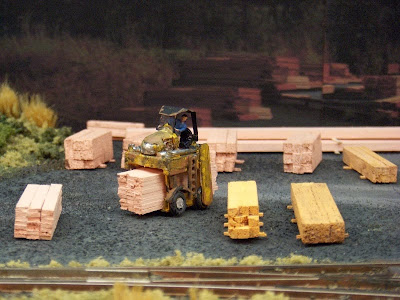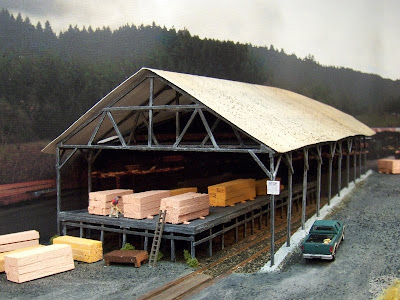
Hull-Oakes, one of the last steam-powered sawmills in North America, is located on the end of a six mile spur in the foothills of the Coastal Mountain Range. Until 2007, when a rail embargo began, the mill shipped large dimensional lumber and woodchips by rail.
Being at the end of the spur, and with limited sidings, it presents an interesting switching puzzle. The layout has compressed this into a 3-2-2 Inglenook puzzle, and requires that the empty cars be switched in to the correct locations, and the full cars switched out. To further complicate the problem, a caboose is required on the end of the consist since the train must reverse the final six miles to reach the mill.
 The layout includes a loading shed, which was scratchbuilt using Midwest Micro-cut scale lumber. The shed and it's dock were used to hand-load boxcars in the 40's & 50's. As flat cars and centerbeams displaced the boxcars, the shed became a covered storage area. Also shown is the mill's unique chip loading station. Woodchips from several areas on the site are blown to the loader using low-pressure air. A chain and motor pulls the railcars back and forth to evenly load them. The mill also uses wood chips to fire a boiler which provides steam to a number of points in the mill, including the 1908 Ames two-cylinder steam engine that powers the headrig band saw. Look around and let me know what you think. I hope this inspires you to give model railroading a try and to learn more about Hull Oakes.
The layout includes a loading shed, which was scratchbuilt using Midwest Micro-cut scale lumber. The shed and it's dock were used to hand-load boxcars in the 40's & 50's. As flat cars and centerbeams displaced the boxcars, the shed became a covered storage area. Also shown is the mill's unique chip loading station. Woodchips from several areas on the site are blown to the loader using low-pressure air. A chain and motor pulls the railcars back and forth to evenly load them. The mill also uses wood chips to fire a boiler which provides steam to a number of points in the mill, including the 1908 Ames two-cylinder steam engine that powers the headrig band saw. Look around and let me know what you think. I hope this inspires you to give model railroading a try and to learn more about Hull Oakes.Next stop? Take a layout tour!





















































